This is the homemade enchilada sauce I always come back to. Ancho chili peppers give it a rich, complex flavor that works wonders when it's gooped over some crispy corn tortillas.
Enchilada sauce also happens to freeze quite well, so I've gotten in the habit of making an oversized batch and freezing a few portions. This recipe will make 10-12 cups of otherworldly enchilada sauce that will officially outlaw store-bought enchilada sauce from your pantry.
Homemade Enchilada Sauce
You've got some leeway on the chili peppers used in this recipe. If you've got Guajillos or New Mexican chilis on hand feel free to add some in, but the Anchos seem to create the most flavor so I would recommend building the sauce around those. (Are Ancho chilis hot?)
These guys were a bit smaller than usual so I'm using 20 of them for this batch -- 15 normal sized Anchos would be a good equivalent.
If you're new to Anchos try to buy the ones that are soft and pliable, like big raisins. If they're brittle they are probably older and will have lost a bit of their flavor.
Start by giving them a once-over and wipe off any dusty crevasses with a damp paper towel. Cut off the stems and de-seed them, but don't worry about getting rid of every last seed.
Roasting dried chilis will wake up some dormant flavors, so I typically throw these in a 400F oven for 1-2 minutes. An alternative would be to use a hot, dry skillet to give them a flash roast (15-30 seconds).
Keep in mind that burnt chilis will turn your sauce bitter, so definitely stay on the cautious side when roasting them. If the edges crisp up and start to disintegrate then you've crossed into the dreaded Burnt Zone.
Once roasted, add them to a bowl and cover them with the hottest tap water you've got. This will reconstitute them and make them more amenable to being ground up.
If they float to the surface you can use a small plate or bowl to keep them submerged. These will need about 20-30 minutes to reconstitute and this will give you plenty of time to gather the other ingredients.
Add 7-8 plum tomatoes to a 400F oven and roast them for 20-30 minutes. This is about 1.5 pounds of tomatoes; feel free to substitute other tomato varieties.
Meanwhile, roughly chop up 3 onions and saute them in a dollop of oil over mediumish heat. You can also add 7-8 garlic cloves but don't worry about mincing up the garlic as all of this will head to the blender eventually. Cook until the onions are lightly browned.
Okay before we blend the sauce together I want to mention the Bitter Dilemma that comes about when using dried chilis.
By now the chilis have fully reconstituted. Take a taste of their soaking liquid. Does it taste bitter to you?
It usually tastes a little bitter to me so I tend to not use the soaking liquid in sauces. Instead, I typically use stock to liquefy the sauces.
But half the world will say it tastes earthy and will crave more of that flavor. Those peeps are good candidates for using the soaking liquid.
Also keep in mind that there are other ways to reign in the bitter undertones of sauces. For example, in our Colorado Enchiladas we use a sliver of chocolate and some adobo sauce to counter the earthy flavor and the result is delish.
To summarize, I like this sauce best when the earthy flavor is mild, so we're using stock and the sweetness of the roasted tomatoes to keep it that way.
Okay enough chatting, in a blender we're going to combine the drained chilis, tomatoes, the onion mixture, and the stock.
You'll probably have to blend this in two batches because there is loads of it.
Give it a whirl until it's thoroughly combined and strain this mixture through a fine-mesh sieve. You can discard the leftover seed and skin remnants. You'll probably have to smoosh it through the sieve using the back of a spoon.
You're left with a bowl full of unlimited potential. Nice!
But don't eat it yet!
Heat up a dollop of oil (or lard!) in a saucepan over medium heat. Add the sauce to the pan along with:
1 tablespoon Mexican oregano
1 teaspoon cumin
2 teaspoons salt
freshly cracked black pepper
I think Mexican oregano works really well in this sauce so keep an eye out for some if you don't normally stock it. But don't sweat it if you don't have any, you can just omit it altogether and you'll still end up with a good batch.
Let this simmer for 30-45 minutes, or until it has reduced down to a velvety consistency. It'll cling to the tortillas better if it's a bit thicker.
This simmer also helps the flavors meld together so trust me it is worth it even if you're getting hungry!
Take a final taste for seasoning. I added another pinch of salt to this batch.
You're left with 10-12 cups of otherworldly enchilada sauce. I typically freeze a few portions in Mason jars. You'll fit just over 2 cups of sauce in each jar and this is a good amount for a 2-person meal.
I think it's easiest to freeze these with the lids off and then once frozen you can cap them. Be sure to leave a bit of headroom as it will expand a bit as it freezes.
You can also freeze some of the sauce in Ziploc bags if you want to.
Okay you've got some awesome red enchilada sauce, now what?!!
My default is to use this sauce for a batch of chicken enchiladas. We have a detailed post on these enchiladas here, but here's the quick skinny on them...
Shredded chicken works best for the enchiladas, so you can use shredded rotisserie chicken or you can poach chicken breasts while the sauce is simmering.
Once you've got cooked chicken on hand, warm up 7-8 corn tortillas; this will make them easier to roll. (I usually put them in the oven for a couple minutes to warm them up.)
Add some of the sauce to a plate and dredge a tortilla in it. Flip it over and fill with chicken, cheese, and some finely chopped onion.
Roll tight and add them to a baking dish. You can put a layer of the enchilada sauce on the baking dish to prevent sticking.
Drench them with the enchilada sauce and give the dish a jiggle so that you get sauce in between the enchiladas.
Bake this at 400F for 10-15 minutes or until the cheese is all gooey and delish.
You can serve as is and your fam will be plenty happy, but of course garnishing with Crema, cilantro, or a bit of Cotija never hurts.
That's 8 enchiladas in the above baking dish and 2 cups of enchilada sauce is a good amount for that batch; this will easily feed two hungry people.
And if all went according to plan you've now got 10-12 cups of the enchilada sauce on hand. If cooking for two, that's easily 5-6 meals you've got on standby. Well done!
Okay, please let me know if you have any questions about this enchilada sauce. It's worth getting familiar with the technique as the flavor will knock the socks off the local competition.
Buen Provecho.
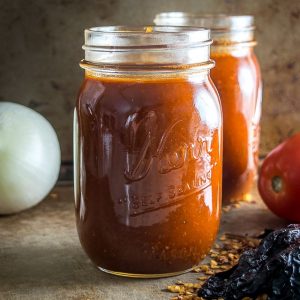
Homemade Enchilada Sauce
Ingredients
- 15-20 dried Ancho chili peppers
- 7-8 plum tomatoes (approx. 1.5 pounds)
- 3 onions
- 8 garlic cloves
- 8 cups stock
- 1 tablespoon Mexican oregano
- 1 teaspoon cumin
- 2 teaspoons salt
- freshly cracked black pepper
Instructions
- Wipe off any dusty crevasses on the dried chilis. De-stem and de-seed the chilis, but don't worry about getting rid of every last seed.
- Roast the chili pieces for 1-2 minutes in a 400F oven. Add them to a bowl and cover them with hot tap water. Let the chilis reconstitute for 20-30 minutes. If they float to the surface you can use a small bowl or plate to keep them submerged.
- Roast 7-8 plum tomatoes in a 400F oven for 20-30 minutes.
- Roughly chop 3 onions and peel 8 garlic cloves. Add a dollop of oil to a skillet on medium heat and saute the onions and whole garlic cloves until lightly browned.
- You'll probably have to combine the ingredients in two batches. Add half of the tomatoes, chilis, onion mixture, and stock to a blender and combine well. Strain the sauce through a fine mesh sieve and discard the leftover skin and seed remnants. You might have to use the back of a spoon to push the sauce through the strainer.
- Add a dollop of oil to a saucepan on medium heat. Add the enchilada sauce along with 1 tablespoon Mexican oregano, 1 teaspoon cumin, 2 teaspoons salt, and some freshly cracked black pepper. Simmer for 30-45 minutes or until it has reduced down to a velvety consistency. Take a final taste for seasoning.
- Let the sauce cool and then portion it into 2-cup portions (or larger if you want to, you'll have about 10-12 cups total). I typically keep a portion in the fridge and the rest in the freezer. Mason jars and Ziplocs are both good options for storing in the freezer.
- If you want to make a batch of chicken enchiladas, please see our Ancho Chicken Enchiladas post for details.
Notes
We use similar techniques to make a batch of authentic Adobo Sauce.
Still hungry?!
Want to receive Mexican Please recipes via email when they are posted? Sign up below to subscribe. All recipes are spam free.


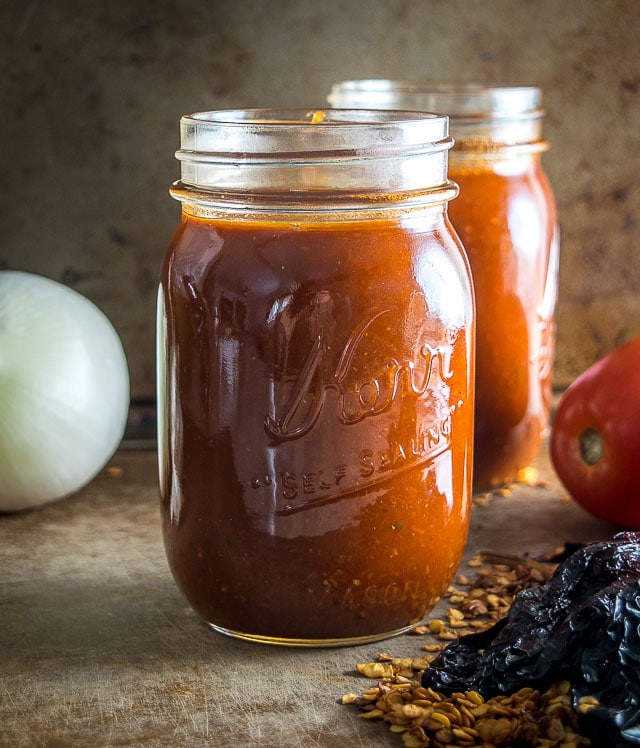
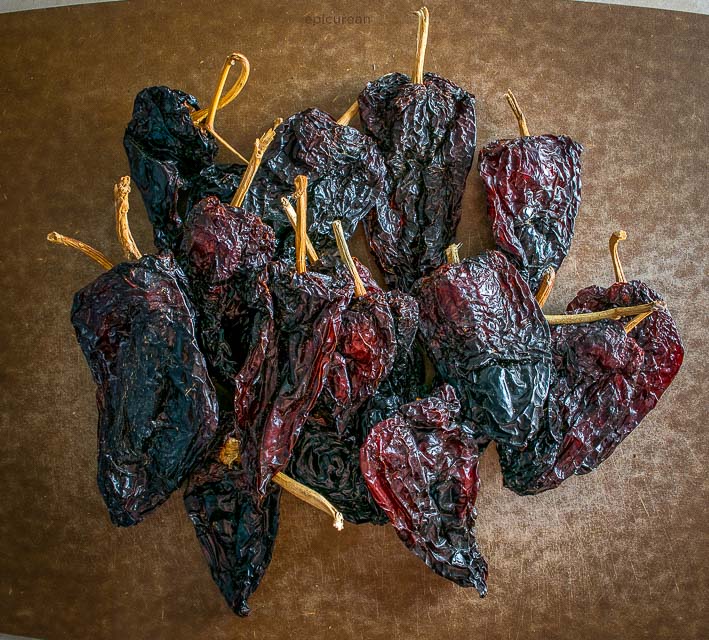
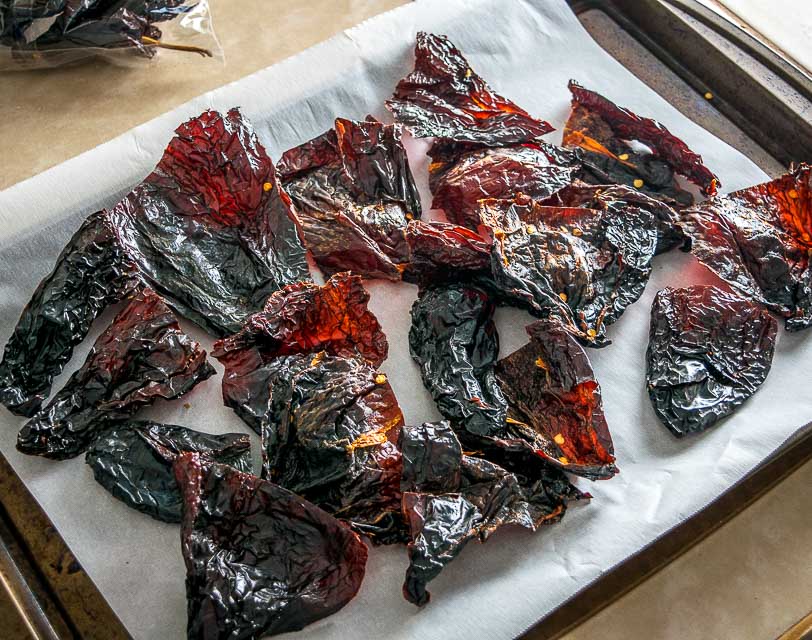
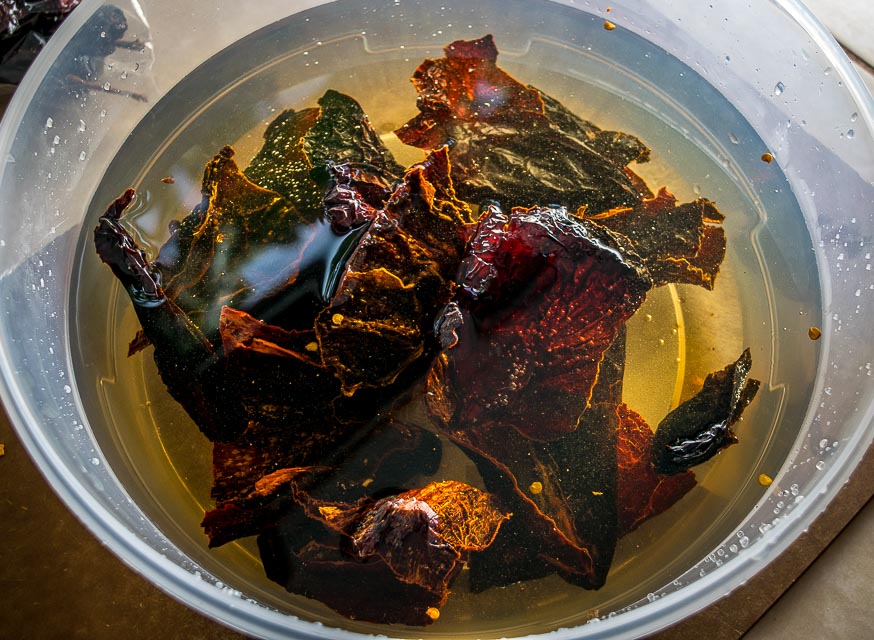
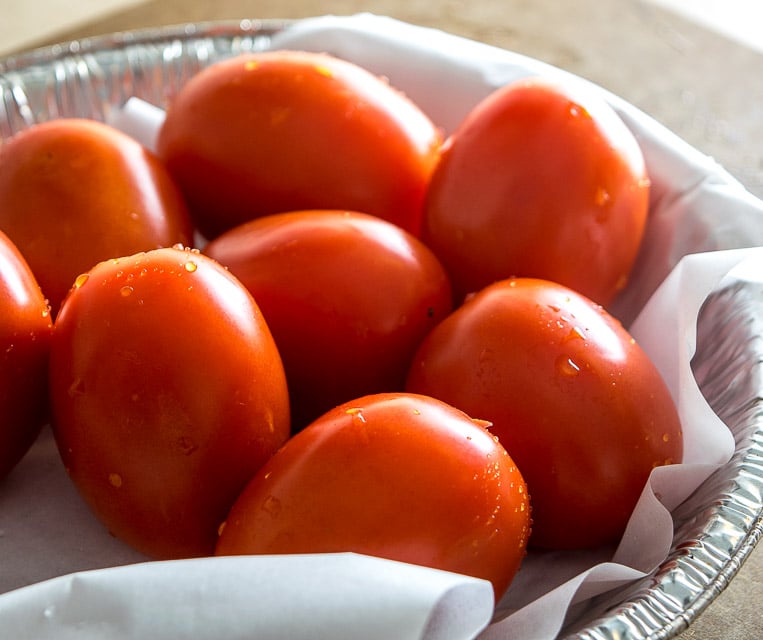
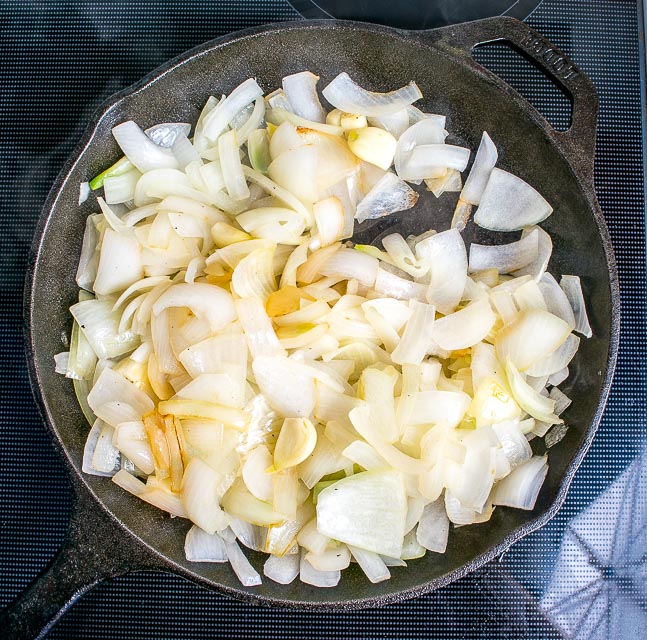
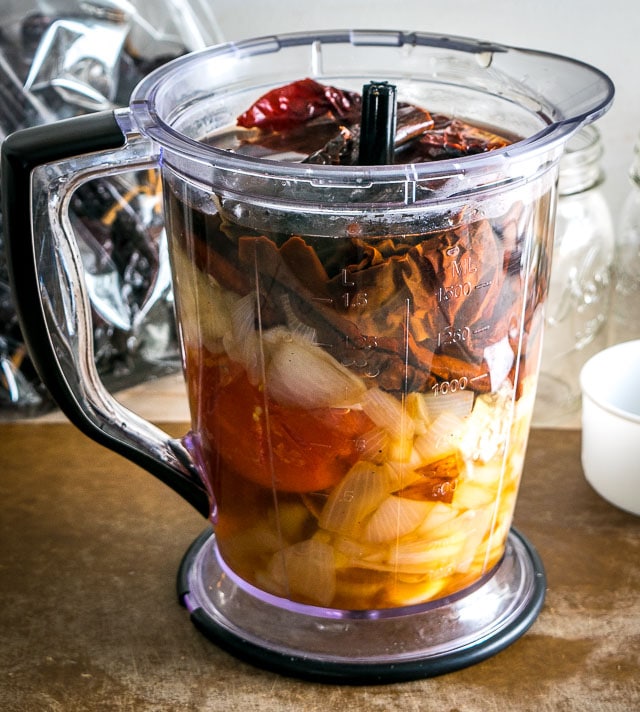
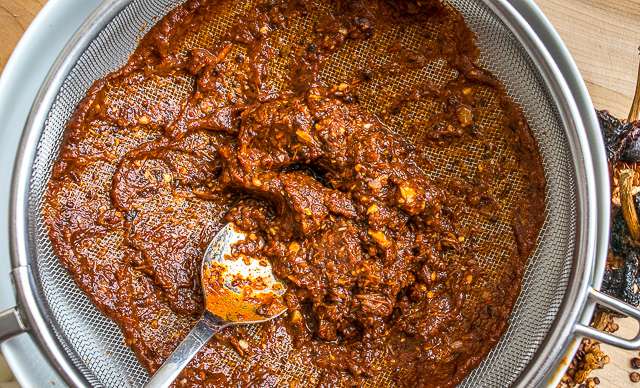
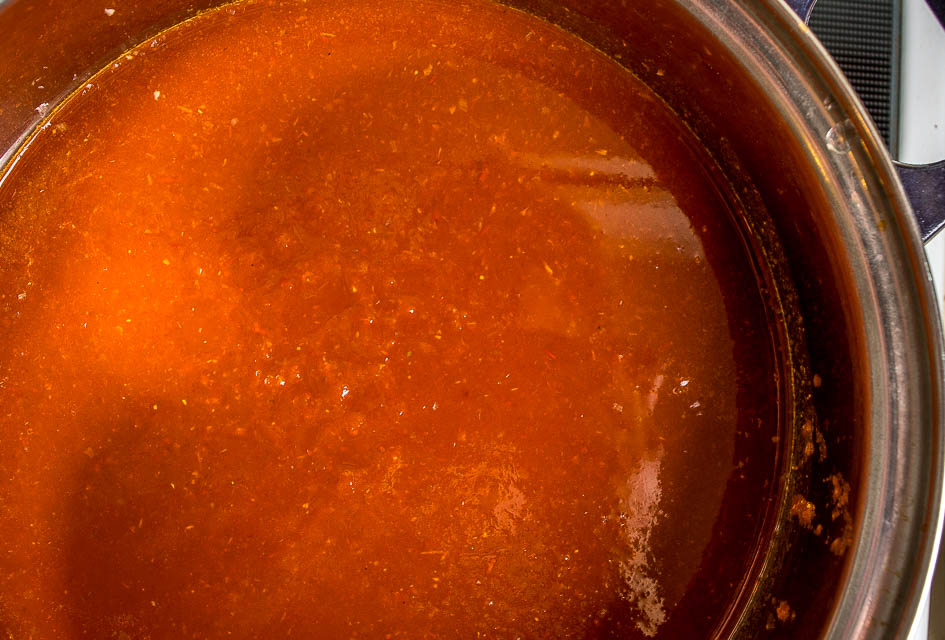
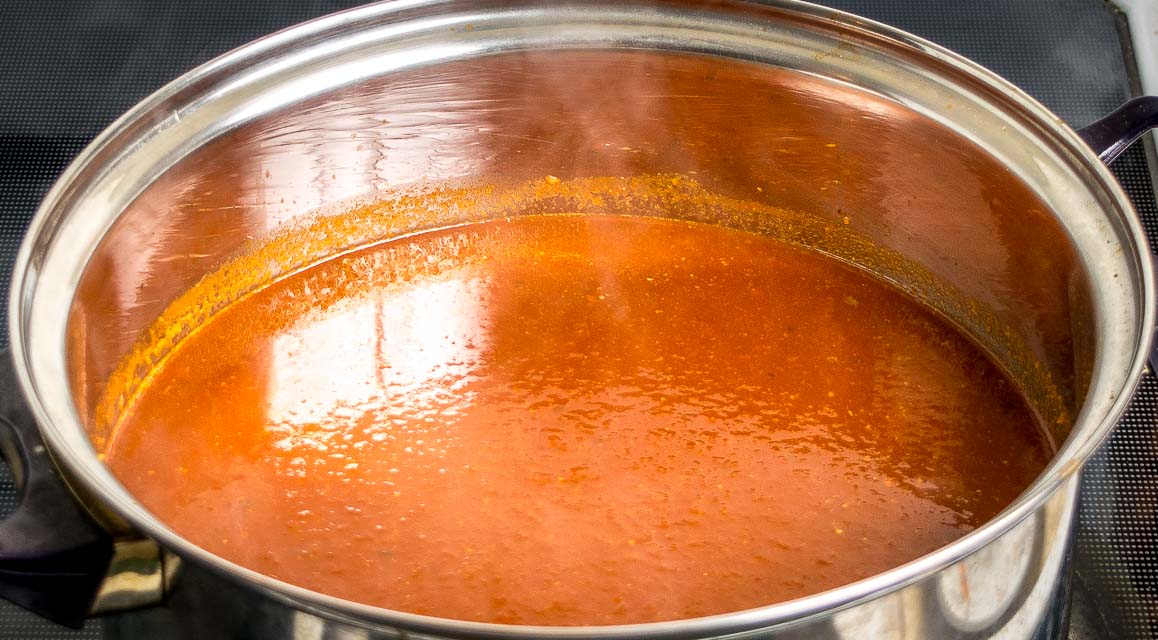
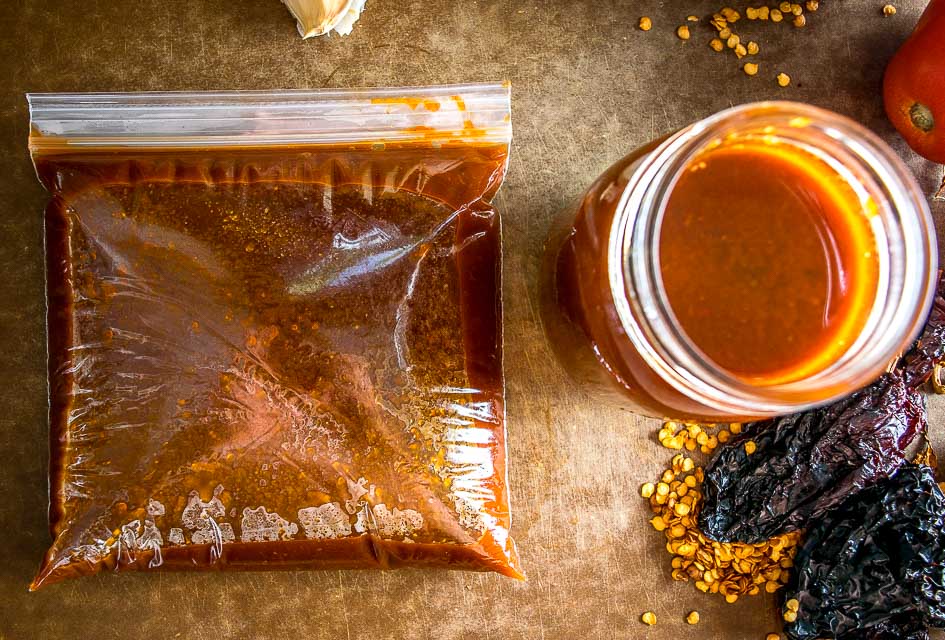
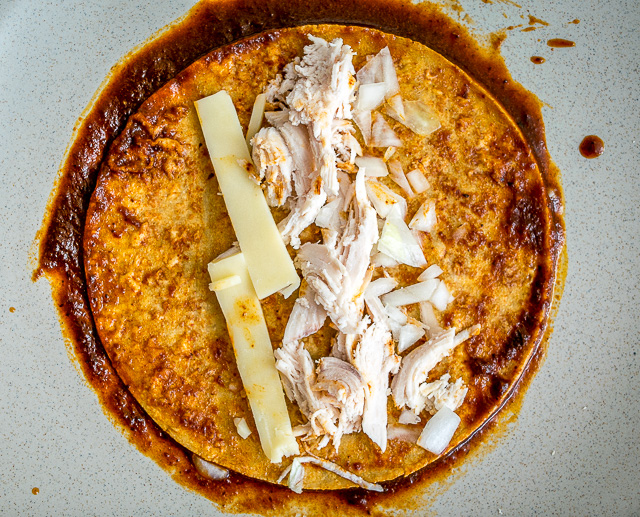
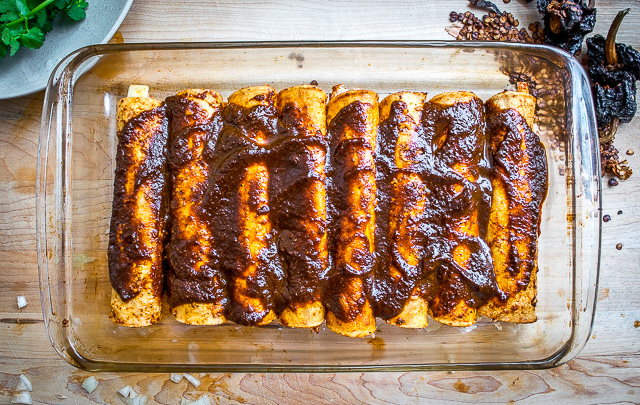
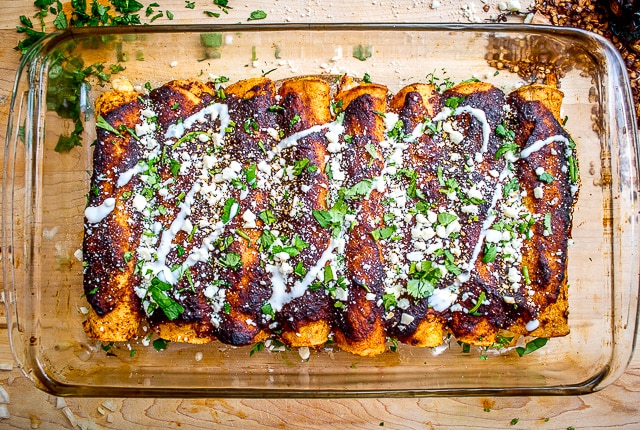
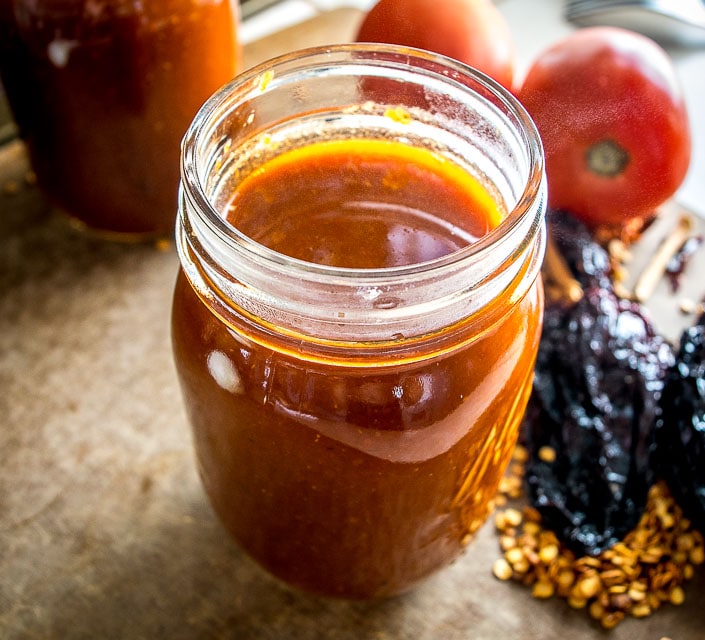
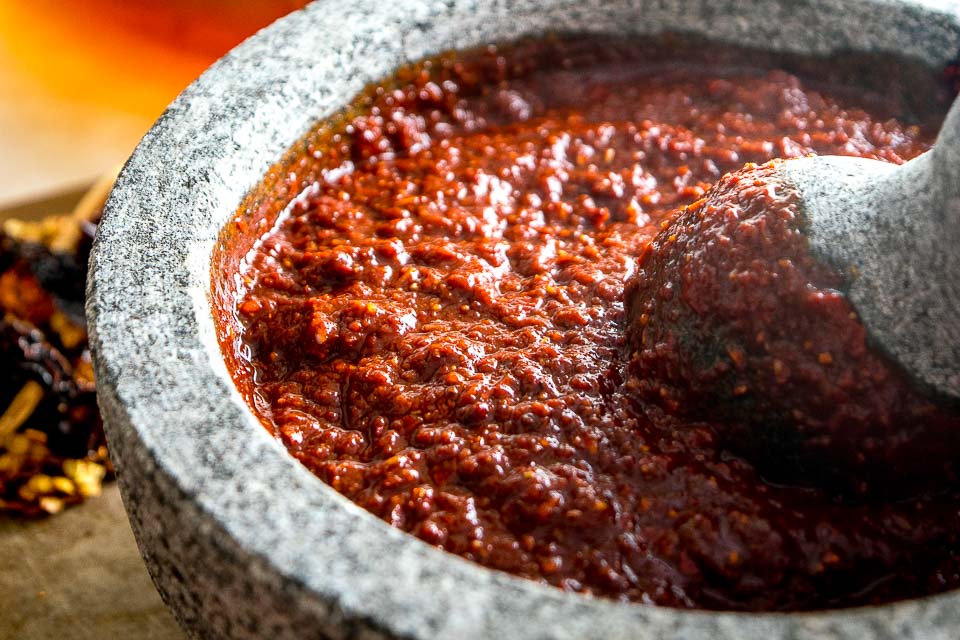
Ali
Maybe I missed it, but when do you add the stock?
Patrick
Hi Ali! You add the stock to the blender right before blending. Cheers.
John Buckley
First, thanks for this website. I came back from a trip to California in December, determined to up my Mexican cooking game. Luckily I found your website, and it has been a huge help.
I have just made your enchilada sauce. I’m a little confused by the blending/straining operation. You say to blend the ingredients until “well combined”, but I’m not sure what that means. I’m ending up with a purée that doesn’t have any pieces of skin or seeds to strain out. Am I overdoing it? I tried to force it through my strainer anyway, but I finally gave up.
The consistency of the sauce is about what I would expect, and it’s trying to taste really good, but there’s a certain harshness to it that is slightly objectionable. The same thing happened when I made the purée for the Pozole recipe last week (it was still pretty good, though). I’m not using the soaking liquid.
Is it the puréed skin that’s making it a little harsh? I don’t see how you can blend it until it’s smooth and still have removable pieces of skin left.
Any ideas?
Patrick
Hey John thanks for your note, so glad to hear you doing some real deal Mexican cooking at home!
You're doing everything right it just sounds like your palate is reacting to the astringency or bitterness that is inherent in these dried chiles. I was super frustrated with this when I first started cooking Mexican and had many duds along the way before finding the sweet spot.
It's basically just a matter of finding the right balance for your palate. I am less tolerant of this astringency than most people, and it sounds like you may be a step further on that spectrum, but once you find the right balance for your palate you'll be able to get all the goodness from dried chiles without that bitter aftertaste.
First things first....be sure to use dried chiles that are pliable and squishy. If they are hard and brittle they are past their prime and this will sometimes increase their bitterness. Most dried chiles in the supermarket chains have been sitting there for too long, so I try to buy them from a good Hispanic market or get well reviewed 1 lb. bags from Amazon.
Roasting chiles for too long will also make them bitter, so if I were in your shoes I would cut down that roasting time just a bit until you find the sweet spot. I typically put them in the oven for 2 minutes, so I would try a single minute in your case to see if that makes a difference.
And last, I've found that when I counter the subtle bitterness of dried chiles with some sweetness then it goes away. The enchilada sauce above is a great example of that. I initially experimented with an enchi sauce using only dried chiles as that is what I came across in Mexico, but that was way too bitter for my palate. Adding in some sweetness from roasted tomatoes countered that bitterness and seemed to let the chiles contribute their flavor but with minimal astringency. So if the above suggestions don't work then it might be worth amping up the sweetness a bit by adding another tomato to your enchi sauce. If you're going to experiment with that I would use the original Ancho Enchilada Sauce recipe so that you don't have to make a huge batch each time.
In the case of the recent Bacon Red Pozole, I think it's the aromatics and fixings that create a tasty, satisfying counterpart to the dried chiles. So if you make that one again and taste that harshness that you mention, then it's worth increasing the aromatics (particularly the cumin and Mexican oregano) and ensuring that you have some acidity in the fixings (like the limey cabbage). This creates a "complete" flavor for my palate without any astringency from the chiles.
And last...don't worry about straining out any skin for flavor purposes. I mention that step for texture purposes only -- it makes enchi sauce silky smooth but won't affect the final flavor.
Okay, I hope this helps a bit! I know exactly where you're at as I was there too...it will just take another round or two to find the sweet spot for your palate and that will give you a lifetime's worth of goodness from dried chiles 🙂
John Buckley
Patrick,
Thank you so much for your thoughtful reply. I’ll definitely try your suggestions soon, in fact I just stocked up on dried peppers yesterday - ancho and guajillo. Got them from our local Mexican grocery (an awesome place!), they seem fresh, soft and pliable.
Thanks again.
Patrick
Ahh good news...I get tons of mileage from that Ancho/Guajillo combo. Cheers.
Kelly
Hi there! I love your website and all of the recipes that I have tried so far. Thank you for putting it all together. I have a question about the Homemade enchilada sauce. Could this be canned safely in a pressure canner so it doesn't take up room in the freezer? Thanks in advance!
Patrick
Thanks Kelly, so glad to hear you are finding some good stuff on my site!
Sorry I can't give a better answer, but I haven't tried any long term preserving with this recipe yet so can't say for sure one way or the other. Will add it to my list though. Cheers.
JH
Thank you Patrick. I've been curious about using dried chilies for years. Now I have a good reason to experiment, and your excellent instructions to follow.
Patrick
Yeah go for it JH, this is a great sauce to start with if you are new to dried chiles. Don't forget to take a taste of the chiles' soaking liquid as that will give you a quick yay or nay for using that liquid in your sauces. Cheers.
Joe
Thanks for including the weight for the tomatoes.
Suzy
Hello Patrick! Can I use fresh poblanos in this? Just roast & de-skin? And if so, do you think the same amount or less? I'm just finishing up the garden and have a poblano plethora! Ha!
Patrick
Hi Suzy, sorry to say but the poblanos won't work for this recipe. Even though Anchos start out life as a Poblano they have a completely different flavor profile once they are dried out. Cheers.
P.S. If I were you I'd make Poblano Soup 🙂
Carol
I am hooked on your recipes! Soo good! Just made enchilada sauce for supper tonight. Freeze the rest. Always wind up at your site if I have a question or want to make something different. Thank you soo much, Carol
Patrick
Ahh good to know, so glad you are finding some keepers on my site Carol! Cheers.
Paul
I hate you. 🙂 I can never buy canned sauce again.
Patrick
Ha ha, yes this is the only possible downside of good home cooking...the usual shortcuts will no longer be an option 🙂
Susan Kara
Patrick, I can always count on you for a recipe that delivers and your enchilada sauce was one of them. I made the sauce and used 1 cup in a crock pot with 1 pound of boneless pork shoulder, served over rice with , believe it or not, canned pinto beans and the meal was a huge success. Thank you so much. Thank you for sharing.
Patrick
Oh nice that sounds like a great meal Susan! Cheers.
Jenna Blythe-Tjia
Hola Patrick!
I am gearing up to use your recipe this weekend. My hubs and I are strict vegetarian, so I have a question about the "stock." Would vegetable stock suffice? Additionally, do you have a vegetarian recipe for Mexican rice, green chile rice, etc.? I MUST have this in or as a side with my enchiladas. For the life of me, I cannot find a good one that is vegetarian and when I make it, it's just not good enough to serve to guests. Thoughts, amigo? 🙂
Vamos y gracias!
Patrick
Hey Jenna! Yeah absolutely you can use veggie stock in this recipe -- you'll be getting most of the flavor from the other ingredients so you'll get an equally good result.
And the same can be said for my rice recipes -- I usually default to chicken stock when making rice because that's what my freezer typically has, but you'll still get a great result using veggie stock. Here are some options for you:
Mexican Rice
Mexican Green Rice
Cheers.